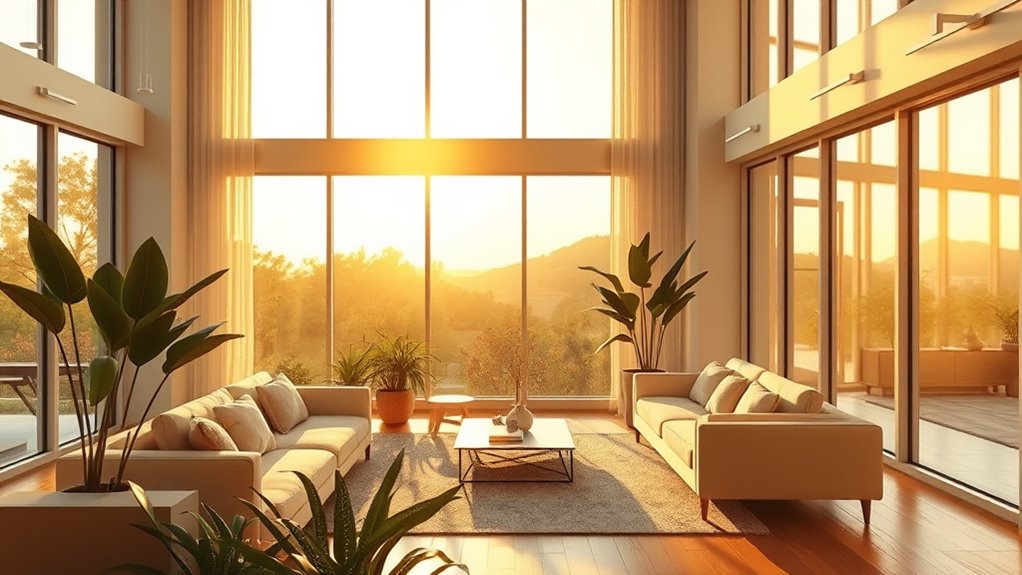Designing your home with circadian lighting helps match your environment to your biological clock, enhancing your sleep and daily energy levels. You can use adjustable lighting systems that mimic sunrise and sunset, gradually changing brightness and warmth throughout the day. This setup promotes better rest, boosts alertness during your waking hours, and reduces reliance on stimulants. To learn how to create a personalized circadian lighting plan, explore the next steps in incorporating this natural rhythm into your home.
Key Takeaways
- Incorporate adjustable lighting that simulates natural sunlight patterns to align indoor environments with your biological clock.
- Use smart control systems to automatically shift lighting from bright, cool tones in the day to warm, dim lighting at night.
- Design home lighting to gradually brighten in the morning and warm in the evening, promoting healthy sleep and alertness cycles.
- Select energy-efficient fixtures that adapt color temperature and brightness based on time of day for optimal circadian support.
- Integrate circadian lighting with daily routines to enhance mood, improve sleep quality, and boost overall well-being.

Circadian lighting is designed to align artificial light exposure with your body’s natural biological rhythms, helping you feel more alert during the day and better rested at night. By mimicking the natural variations of sunlight, it promotes sleep optimization and enhances your overall well-being. When your home’s lighting adjusts to your circadian rhythm, you can experience improved sleep quality, reduced fatigue, and better mood regulation. This not only supports your health but also contributes to energy efficiency, as lighting uses less power when it adapts to your daily patterns instead of relying on static, traditional lighting systems.
Circadian lighting aligns your home’s light with your natural rhythms, improving sleep and boosting overall well-being.
As you go about your day, circadian lighting systems gradually brighten in the morning, providing a boost of energy to kickstart your activities. This simulates sunrise, signaling your body to wake up and increase alertness. During the day, the lighting remains vibrant but not overly harsh, helping you stay focused without the strain associated with artificial light that’s too intense or poorly timed. Additionally, the integration of lighting control systems can further enhance the effectiveness of circadian lighting by allowing seamless adjustments based on your schedule and preferences.
As evening approaches, the lights dim and shift to warmer tones, encouraging melatonin production and preparing your body for sleep. This natural shift reduces the likelihood of disruptions caused by overly bright or blue-rich light at night, which can interfere with your circadian rhythm.
Implementing circadian lighting in your home can considerably improve sleep patterns, especially if you work irregular hours or experience difficulty winding down. Better sleep not only benefits your mental and physical health but also enhances daytime energy levels, making you more productive and less dependent on caffeine or stimulants.
Additionally, because these lighting systems are often designed with energy efficiency in mind, they consume less power than conventional lighting. By adjusting brightness and color temperature based on the time of day, you save on electricity bills and reduce your carbon footprint, all while supporting your natural biological clock.
You’ll find that adjusting your home’s lighting with circadian principles is a straightforward way to optimize your daily routine. It encourages your body to follow its internal clock, leading to more restorative sleep and increased daytime alertness.
As a result, your overall quality of life improves, and you enjoy a healthier balance between activity and rest. With energy-efficient technology built into these systems, you don’t have to compromise on sustainability or comfort. Instead, you create an environment that respects your natural rhythms, helping you feel your best every day.
Frequently Asked Questions
Can Circadian Lighting Improve Sleep Quality for Shift Workers?
Yes, circadian lighting can improve your sleep quality as a shift worker. It helps by mimicking natural light, which supports light therapy and enhances melatonin regulation.
Proper lighting adjustments during your waking hours can boost alertness, while softer, warmer light at night encourages melatonin production. This balance helps reset your internal clock, making it easier to fall asleep and wake up refreshed, even with irregular work hours.
How Does Circadian Lighting Affect Individuals With Seasonal Affective Disorder?
Oh, the joys of seasonal affective disorder—like a moody weather forecast in your brain! Luckily, circadian lighting steps in as a hero, helping regulate melatonin and boost mood.
You’ll find your mood brightening and sleep improving as the lighting mimics natural sunlight, encouraging your body’s biological clock to dance in sync. It’s like a personal sunshine, even on the gloomiest days, making you feel better all year round.
Is Circadian Lighting Suitable for Children’S Bedrooms?
You might wonder if circadian lighting is suitable for children’s bedrooms. It can support healthy sleep patterns and promote proper child development by mimicking natural light cycles.
In nursery lighting, using adjustable, soft lighting helps create a calming environment, aiding sleep and alertness.
Properly designed circadian lighting benefits your child’s growth, mood, and overall well-being, making it a good choice for their bedroom space.
What Are the Energy Costs Associated With Circadian Lighting Systems?
Think of circadian lighting as a finely tuned engine—designed for efficiency. The energy costs depend on your system’s energy consumption and efficiency.
While these systems might use slightly more power during setup, they’re often smart enough to reduce consumption over time by adjusting brightness and timing.
Can Circadian Lighting Be Integrated With Smart Home Automation?
You can definitely integrate circadian lighting with your smart home system, making automation compatibility seamless. By linking your lighting to smart home devices, you gain control over automatic adjustments that match your daily rhythm.
This setup allows your lights to adapt to the time of day, enhancing comfort and energy efficiency. With smart home integration, you can customize and automate your circadian lighting to create a healthier, more synchronized living environment effortlessly.
Conclusion
By embracing circadian lighting, you’ll open the secret to a life so energized, you’ll feel like you’ve discovered the fountain of youth! Your mornings will burst with unstoppable vitality, and your nights will be so peaceful, you’ll drift into dreams so sweet they could make fairy tales jealous. It’s like giving your home a superpower—turning ordinary days into extraordinary adventures just by syncing with your body’s natural rhythm. Get ready to live brighter, better, and way more awesome!










